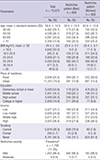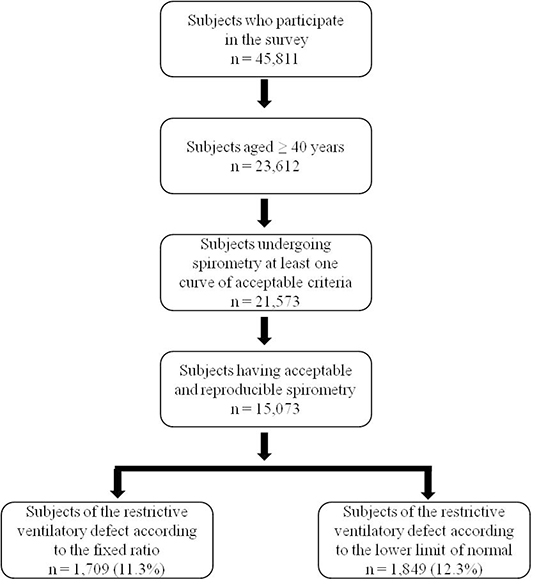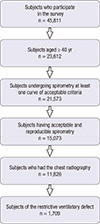1. Mannino DM, Thorn D, Swensen A, Holguin F. Prevalence and outcomes of diabetes, hypertension and cardiovascular disease in COPD. Eur Respir J. 2008; 32:962–969.
2. Mannino DM, Doherty DE, Sonia Buist A. Global Initiative on Obstructive Lung Disease (GOLD) classification of lung disease and mortality: findings from the Atherosclerosis Risk in Communities (ARIC) study. Respir Med. 2006; 100:115–122.
3. Crapo RO. Pulmonary-function testing. N Engl J Med. 1994; 331:25–30.
4. Venkateshiah SB, Ioachimescu OC, McCarthy K, Stoller JK. The utility of spirometry in diagnosing pulmonary restriction. Lung. 2008; 186:19–25.
5. MacIntyre NR, Selecky PA. Is there a role for screening spirometry? Respir Care. 2010; 55:35–42.
6. Aaron SD, Dales RE, Cardinal P. How accurate is spirometry at predicting restrictive pulmonary impairment? Chest. 1999; 115:869–873.
7. Soriano JB, Miravitlles M, García-Río F, Muñoz L, Sánchez G, Sobradillo V, Durán E, Guerrero D, Ancochea J. Spirometrically-defined restrictive ventilatory defect: population variability and individual determinants. Prim Care Respir J. 2012; 21:187–193.
8. Ford ES, Wheaton AG, Mannino DM, Presley-Cantrell L, Li C, Croft JB. Elevated cardiovascular risk among adults with obstructive and restrictive airway functioning in the United States: a cross-sectional study of the National Health and Nutrition Examination Survey from 2007-2010. Respir Res. 2012; 13:115.
9. Lindberg A, Larsson LG, Rönmark E, Lundbäck B. Co-morbidity in mild-to-moderate COPD: comparison to normal and restrictive lung function. COPD. 2011; 8:421–428.
10. Guerra S, Sherrill DL, Venker C, Ceccato CM, Halonen M, Martinez FD. Morbidity and mortality associated with the restrictive spirometric pattern: a longitudinal study. Thorax. 2010; 65:499–504.
11. Kweon S, Kim Y, Jang MJ, Kim Y, Kim K, Choi S, Chun C, Khang YH, Oh K. Data resource profile: the Korea National Health and Nutrition Examination Survey (KNHANES). Int J Epidemiol. 2014; 43:69–77.
12. Miller MR, Hankinson J, Brusasco V, Burgos F, Casaburi R, Coates A, Crapo R, Enright P, van der, Gustafsson P, et al. Standardisation of spirometry. Eur Respir J. 2005; 26:319–338.
13. Choi JK, Paek D, Lee JO. Normal predictive values of spirometry in Korean population. Tuberc Respir Dis. 2005; 58:230–242.
14. Aggarwal AN, Agarwal R. The new ATS/ERS guidelines for assessing the spirometric severity of restrictive lung disease differ from previous standards. Respirology. 2007; 12:759–762.
15. Hwang YI, Kim CH, Kang HR, Shin T, Park SM, Jang SH, Park YB, Kim CH, Kim DG, Lee MG, et al. Comparison of the prevalence of chronic obstructive pulmonary disease diagnosed by lower limit of normal and fixed ratio criteria. J Korean Med Sci. 2009; 24:621–626.
16. Organisation for Economic Co-operation and Development. What are equivalent scales? 2010. accessed on 19 November 2010. Available at
http://www.oecd.org.
17. Yoo KH, Kim YS, Sheen SS, Park JH, Hwang YI, Kim SH, Yoon HI, Lim SC, Park JY, Park SJ, et al. Prevalence of chronic obstructive pulmonary disease in Korea: the fourth Korean National Health and Nutrition Examination Survey, 2008. Respirology. 2011; 16:659–665.
18. Guyton AC, Hall JE. Textbook of medical physiology. New Delhi: Reed Elsevier IPL;2006. p. 525–526.
19. Guder G, Brenner S, Angermann CE, Ertl G, Held M, Sachs AP, Lammers JW, Zanen P, Hoes AW, Stork S, et al. "GOLD or lower limit of normal definition? A comparison with expert-based diagnosis of chronic obstructive pulmonary disease in a prospective cohort-study". Respir Res. 2012; 13:13.
20. Reilly KH, Gu D, Duan X, Wu X, Chen CS, Huang J, Kelly TN, Chen J, Liu X, Yu L, et al. Risk factors for chronic obstructive pulmonary disease mortality in Chinese adults. Am J Epidemiol. 2008; 167:998–1004.
21. Poulain M, Doucet M, Major GC, Drapeau V, Sériès F, Boulet LP, Tremblay A, Maltais F. The effect of obesity on chronic respiratory diseases: pathophysiology and therapeutic strategies. CMAJ. 2006; 174:1293–1299.
22. Jordan JG Jr, Mann JR. Obesity and mortality in persons with obstructive lung disease using data from the NHANES III. South Med J. 2010; 103:323–330.
23. Bowen RE, Scaduto AA, Banuelos S. Decreased body mass index and restrictive lung disease in congenital thoracic scoliosis. J Pediatr Orthop. 2008; 28:665–668.
24. Antwi DA, Gbekle GE, Cosmos HK, Ennin IE, Amedonu EA, Antwi-Boasiako C, Clottey MK, Adzaku FK. Analysis of lung function tests at a teaching hospital. Ghana Med J. 2011; 45:151–154.
25. Sharma G, Goodwin J. Effect of aging on respiratory system physiology and immunology. Clin Interv Aging. 2006; 1:253–260.
26. Faggiano P. Abnormalities of pulmonary function in congestive heart failure. Int J Cardiol. 1994; 44:1–8.
27. Lee JH, Chang JH. Lung function in patients with chronic airflow obstruction due to tuberculous destroyed lung. Respir Med. 2003; 97:1237–1242.
28. Lee EJ, Lee SY, In KH, Yoo SH, Choi EJ, Oh YW, Park S. Routine pulmonary function test can estimate the extent of tuberculous destroyed lung. ScientificWorldJournal. 2012; 2012:835031. doi:
10.1100/2012/835031.
29. Lam KB, Jiang CQ, Jordan RE, Miller MR, Zhang WS, Cheng KK, Lam TH, Adab P. Prior TB, smoking, and airflow obstruction: a cross-sectional analysis of the Guangzhou Biobank Cohort Study. Chest. 2010; 137:593–600.
30. Rhee CK, Yoo KH, Lee JH, Park MJ, Kim WJ, Park YB, Hwang YI, Kim YS, Jung JY, Moon JY, et al. Clinical characteristics of patients with tuberculosis-destroyed lung. Int J Tuberc Lung Dis. 2013; 17:67–75.







 PDF
PDF ePub
ePub Citation
Citation Print
Print





 XML Download
XML Download